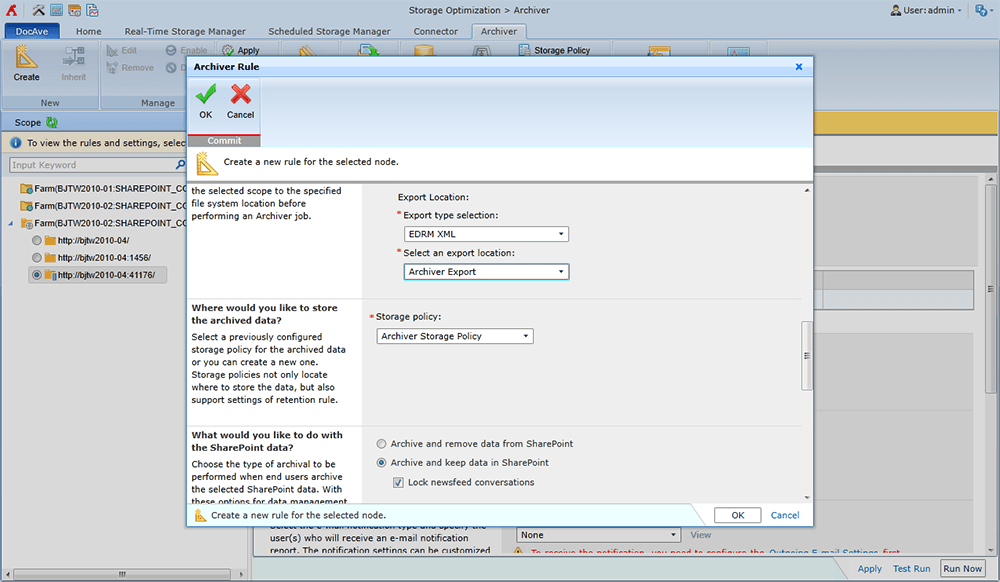Our New Recipes for Record Management
Just as food comes in many shapes, flavors, and varieties, so does record management. We’ve added some new recipes to the Archiver menu to help our customers find the flavor they enjoy and that their organization requires. Digital shredding: A major concern for records managers – particularly in the public sector arena – is the idea of secure deletion of BLOBs from net share physical devices. To address these concerns, we have introduced a new digital shredding feature in SP 4. When they are deleted, Binary Large Objects (BLOBs) are then repeatedly overwritten to ensure that they cannot be resurrected via file system recovery tools. In addition, if orphan BLOBs are deleted, they will no longer be traceable nor able to be reconstructed in the storage location. EDRM XML added as a supported export file format: As mentioned above, a key part of SharePoint records management solutions is integration with eDiscovery and document review functionalities. In addition to the existing ability to search, hold, and export archived SharePoint 2013 and 2010 content with our DocAve eDiscovery module, we have added EDRM XML as a supported file format for exportation of content. [caption id="attachment_3151" align="alignnone" width="630"] Export EDRM XML files with DocAve Archiver in DocAve 6 SP 4.[/caption] Export before or without archiving: For some organizations, records management relies on exporting data to a file share or a specified location in SharePoint to collect and manage information using SharePoint’s native functionality. No matter what your use case is, Archiver has you covered. In addition to storing files in our archive, we have also added the ability to export content according to the scope, criteria, and rules you have configured to a file share or within SharePoint – without the need to externalize the content to our Archive. This functionality was previously available in our DocAve Vault module, and is part of a continued absorption of Vault’s capabilities into Archiver. Support for archiving and exporting SharePoint newsfeed conversations: Another area of concern for SharePoint administrators and records managers is the growth of social capabilities within the platform. Just as documents can be kept as a record, newsfeed posts and replies may be considered as records by your organization and should be retained for compliance and eDiscovery purposes. Moreover, compliance managers may also want to lock down newsfeed posts to prevent inappropriate replies to a discussion, or prevent sensitive data to be shared out within the organization. In SP 4, Archiver introduces the ability to place an immutable lock on newsfeed posts and replies, and to export snapshots of posts and replies for legal and compliance teams to comply with regulations and as content sources for audits, lawsuits, and investigations. For example, if a lawsuit involved Company A stealing trade secrets from Company B, discussions about Company B on Company A's newsfeed may contain information relevant to the case. It would likely be a source of evidence to be handed over during the discovery process, and thus needs to be preserved and exported for further review. In addition, the latest release of DocAve eDiscovery also has the ability to search for, place holds on, and export archived newsfeeds – creating yet another integration point between the modules.
Export EDRM XML files with DocAve Archiver in DocAve 6 SP 4.[/caption] Export before or without archiving: For some organizations, records management relies on exporting data to a file share or a specified location in SharePoint to collect and manage information using SharePoint’s native functionality. No matter what your use case is, Archiver has you covered. In addition to storing files in our archive, we have also added the ability to export content according to the scope, criteria, and rules you have configured to a file share or within SharePoint – without the need to externalize the content to our Archive. This functionality was previously available in our DocAve Vault module, and is part of a continued absorption of Vault’s capabilities into Archiver. Support for archiving and exporting SharePoint newsfeed conversations: Another area of concern for SharePoint administrators and records managers is the growth of social capabilities within the platform. Just as documents can be kept as a record, newsfeed posts and replies may be considered as records by your organization and should be retained for compliance and eDiscovery purposes. Moreover, compliance managers may also want to lock down newsfeed posts to prevent inappropriate replies to a discussion, or prevent sensitive data to be shared out within the organization. In SP 4, Archiver introduces the ability to place an immutable lock on newsfeed posts and replies, and to export snapshots of posts and replies for legal and compliance teams to comply with regulations and as content sources for audits, lawsuits, and investigations. For example, if a lawsuit involved Company A stealing trade secrets from Company B, discussions about Company B on Company A's newsfeed may contain information relevant to the case. It would likely be a source of evidence to be handed over during the discovery process, and thus needs to be preserved and exported for further review. In addition, the latest release of DocAve eDiscovery also has the ability to search for, place holds on, and export archived newsfeeds – creating yet another integration point between the modules.
